You're using an outdated browser. Please upgrade to a modern browser for the best experience.
Please note this is a comparison between Version 2 by Beatrix Zheng and Version 1 by Hassan Ragab El-Ramady.
It is urgent that we increase global food production to support population growth. Food production requires significant resources, amongst them water and energy. Therefore, any losses of food or other agricultural products also means a waste of water and energy resources. A significant amount of these losses occurs during the postharvest stage, primarily during processing and storage. This is considered avoidable food waste. The water-energy-waste nexus (WEW), and its relationship to food production, needs to be investigated from a circular bioeconomy lens. Furthermore, alternative uses of the wastes should be investigated.
- agroecology
- bioenergy
- biorefinery
- compost
- food security
1. Introduction
Agricultural wastes (agro-wastes) are defined as the residues that result from growing cultivated crops and/or during the first processing of raw agricultural products including vegetables, fruits, dairy products, meat, poultry, and other products [1]. Agro-wastes are produced during farming activities including horticultural, seed growing, dairy farming, livestock breeding, grazing, nursery plots, market gardens, and forestry or woodland production [2]. Agro-wastes can be classified into liquid, solid, or slurry forms [1]. Nearly 30% of the agricultural goods produced worldwide end up as agro-wastes. The residues of raw agricultural products may include animal and plant residues (e.g., manure, different crop residues, wastes from activities like pruning, harvesting, growing, fertilization) and applied pesticides (as hazardous and toxic agricultural wastes). Several studies have quantified agro-wastes generation and the environmental consequences of these wastes such as global nutritional and environmental losses due to food wastes [3], using digital agricultural technologies [4] and sustainable management with a focus on reducing food wastes as a more eco-friendly and economical option than treatment [5].
Utilization and management of agro-wastes have also been discussed from different points of view, such as production of pharmaceutical ingredients [6], biochar [7][8], nanomaterials like nano-silica and nanocellulose [9][10], agro-composites for packaging purposes [11], asphalt binder or natural aggregate in concrete [12][13], nano-adsorbents [14], composts [15], bioenergy production or biorefining approaches [16][17][18], and bioactive compounds [19][20][21][22]. The sustainable management of agro-wastes should be adapted under the food-energy-water (FEW) nexus, as agro-wastes are critical resources that, if properly used, can underpin human livelihoods and wellbeing. In this review we will argue that how we treat agro-wastes will impact our ability to achieve the Sustainable Development Goals of the United Nations [23]. The FEW nexus includes natural resources (e.g., energy, land, and water) and wastes. The global demand on the FEW nexus constantly increasing, as reported by many researchers (e.g., [24][25][26]).
We believe that simple illustrations may help in understanding complex situations. Based on the concept that “one photo is worth one thousand words”, we recently published pictorial studies on soil and humans [27], the soil-water-plant-human nexus [28], management of salt-affected soils [29], global soil science education [30], soil restoration and macro-fungi [31], and plant nutrition for human health [32]. Other photographic reviews/mini-reviews were published on agro-practices and activities such as nano-grafting of vegetables [33], sustainable applications of mushrooms [34], nano-farming [35], smart farming [36], smart irrigation [37], and smart-fertilizers [38].
2. Management of Agro-Wastes
The best approach to waste management is to avoid creating waste. The second-best approach is to recycle and re-use agro-wastes to produce compost, organic fertilizers, and other products. Food wastes can be sustainably managed through the 4 R rule: “reduce, reuse, recovery. and recycle” [39]. The sustainable management of agroforestry wastes can be achieved using the sustainable biorefinery by collecting wastes and valorization, or recycling those wastes into valuable products such as organic fertilizers, biofuel, biochar, and industrial chemicals rather than engaging in traditional approaches, which include thermal management, landfilling, and decomposition [40][41]. Other sustainable utilizations of agro-wastes include producing biodegradable polymers [42][43], or in wastewater treatment as adsorbents such as agro-waste based materials made from potato, tomato, apple, banana, citrus, grape, and mango [44]. The management of agro-industrial wastes using solid state fermentation to produce bioactive compounds has been reported in multiple studies (e.g., [45][46]). Agro-industrial by-products are considered a sustainable source for producing a wide array of bioactive compounds [47]. A survey of selected crop wastes and the bioactive compounds extracted from them is given in Table 2.
Table 2. The main bioactive compounds extracted from selected horticultural crops.
| Plant | Family | Agro-Waste | Bioactive Compounds | Refs. |
|---|---|---|---|---|
| Almond: Prunus dulcis (Mill.) D. A. Webb | Rosaceae | Seed coat | Catechin, kaempferol, isorhamnetin, naringenin, quercetin | [48] |
| Apple: Malus domestica (Suckow) Borkh. | Rosaceae | Pomace, seed, peel | Anthocyanins, catechin, caffeic acid, phloretin glycosides, quercetin glycosides | [49] |
| Banana: Musa sp. | Musaceae | Peel, stalk, pulp | Anthocyanins, auroxanthin, cyaniding, catecholamine, delphinidin, flavonoids, hydroxycinnamic, lutein, neoxanthin, α-and β-carotene, β-cryptoxanthin | [50] |
| Date palm: Phoenix dactylifera L. | Arecaceae | Pulp, seed | Phenolic acids, fatty acids, flavonols, sphingolipids, steroids | [51] |
| Durian: Durio zibethinus L. | Malvaceae | Peel, pulp, rind, seed | Glutathione, γ-glutamyl cysteine, pyridoxamine, cysteine, leucine | [52] |
| Grapefruit: Citrus × paradisi Macfad. | Rutaceae | Peel, pulp, seed | Neohesperidosides, naringenin | [53] |
| Lemon: Citrus limon (L.) Osbeck | Rutaceae | Seed, peel, pulp | Apigenin-6, caffeic acid, coumarate, ferulate | [54] |
| Mango: Mangifera indica L. | Anacardiaceae | Exocarp, pulp, seed | Flavonoids, gallates, hydrolysable tannins, methyl gallate, phenolics | [55] |
| Pineapple: Ananas comosus L. Merr. | Bromeliaceae | Stem, pulp, peel | Catechin, epicatechin, ferulate, gallic acid, phenolics | [56] |
| Pomegranate: Punica granatum L. | Lythraceae | Pulp, seed, peel | Anthocyanins, flavonoids, gallic acid, punicalagin | [57] |
| Strawberry: Fragaria × ananassa | Rosaceae | Sepals and peduncles | Phenolic compounds and antioxidant capacity | [58] |
| Carrot: Daucus carota L. |
Apiaceae | Peel | Anthocyanidin, α-carotene, carotenoids, β-carotene | [59] |
| Potato: Solanum tuberosum L. | Solanaceae | Peel, tuber, leaf | Anthocyanin, caffeic acid, carotenoid, lutein, caffeoylquinic acid | [60] |
| Rice: Oryza sativa L. | Poaceae | Husk, straw, bran | Anthocyanins, caffeic acid, phytosterols, pantothenic, niacin, pyridoxine, tricin | [61] |
| Soybean: Glycine max L. Merr. | Fabaceae | Husk | Chlorogenic acid, ferulate, gallic acid | [62] |
| Tomato: Solanum lycopersicum L. | Solanaceae | Peel, pulp, seed | Caffeic acid, chlorogenic acid, lycopene β-carotene, | [63] |
| Wheat: Triticum aestivum L. | Poaceae | Bran | Caffeic acid, ferulate, gallic acid, p-coumaric acid | [64] |
Scientific names were obtained from the website https://powo.science.kew.org/ (accessed on 6 August 2022).
2.1. Agro-Wastes for Recycling and Composting
The most common traditional management of agro-wastes is to plough them into the soil, or to bail or otherwise remove them from the field after harvesting [65]. Crop residues can have both positive and negative impacts on an agroecosystem, depending on the chemical composition of the residue. If the crop grew in polluted soil the residues may contain hazardous materials and/or harmful microbial species that threaten human health [66]. However, several positive outcomes can arise from leaving residues in a field, including mineralization, or release of nutrients, into soils and increased nutrient uptake efficiency [67]. In developing countries, landfilling and/or burning agro-residues after harvest is a common practice [68]. About 35, 85 and 45% of N, P, and K, respectively, taken up by rice plants remain in vegetative parts and may be re-used to feed soil and nourish cultivated plants [69].
Composting is a microbial process, by which the decomposition, biodegradation and bioconversion of agro-residues can be accelerated from complex materials into simpler organic and/or inorganic soluble forms [70]. This process mainly depends on factors including the kind of agro-wastes, their C:N ratio, and environmental conditions such as pH, aeration, moisture content, temperature, etc. (Figure 5, Figure 6 and Figure 7). In general, some essential chemical fertilizers (NPK) need to be applied to start the composting process along with the addition of plant growth-promoting bacteria (PGPB) [69]. The PGPR help decompose and process the compost (i.e., organic matter), forming a bioorganic fertilizer with many bioactive compounds or enzymes that stimulate biological processes that enhance the bioavailability of nutrients to cultivated plants [71]. The role of PGPR may also include enhancing the germination of seeds, growth of plants, soil rehabilitation, and biological suppression of diseases in soil [69]. Furthermore, PGPB can produce phytohormones that mediate nutrient and water uptake and improve plant growth and yield due to high root proliferation [72]. Agro-wastes from horticultural crops are used to extract many bioactive compounds, as reported by Khaksar et al. [73] and in Table 2. The main challenges that face food waste composting include odorous substances and leachate production, which should be collected and treated for pollutants [74].
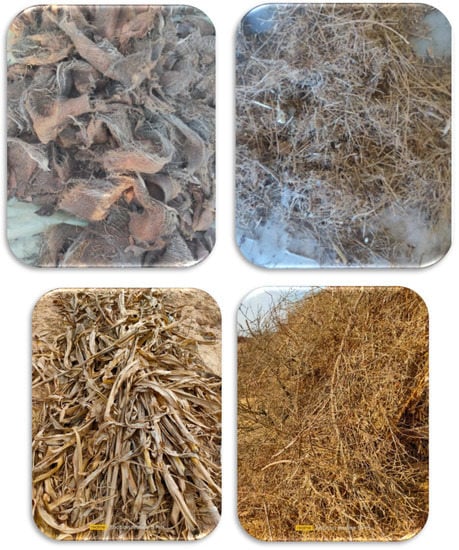
Figure 5. Horticulture and field crops are primary sources for agro-wastes such as date palms. The upper left photo shows waste in a horticultural nursery. The upper right photo shows the same wastes after crushing. The lower photos show maize (left) and citrus (right) residues. Photos courtesy of El-Mahrouk and El-Baily.
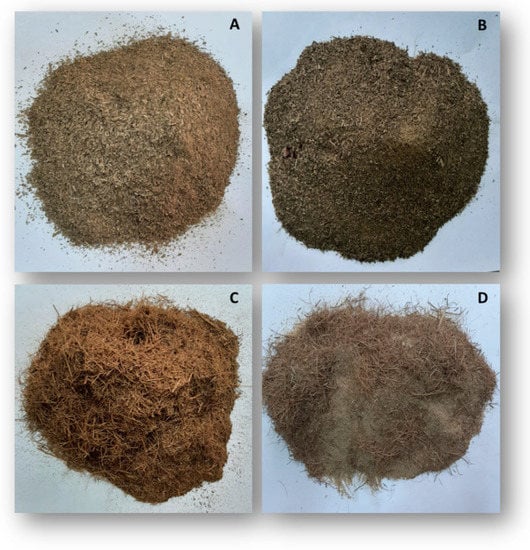
Figure 6. Crushed wastes can be used to prepare compost to improve the properties of sandy soil and be used in growing media in horticultural nurseries. Banana compost (A); banana compost and sand (1:1) (B); date palm compost (C); date palm compost and sand (1:1) (D). Photos courtesy of El-Mahrouk.
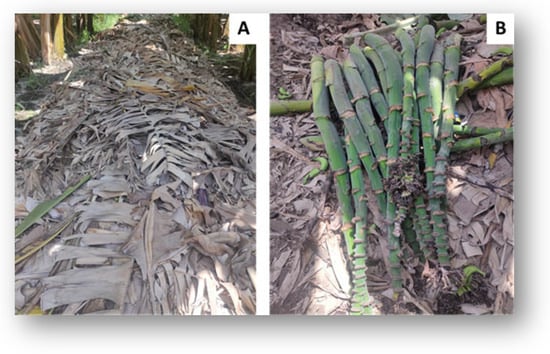

Figure 7. Different kinds of banana wastes, including leaf wastes (A), peduncle wastes (B) (upper photos), pseudo-stem wastes (C,D) (middle photos), and wastes belong in vitro seedlings, which harvested this year (photo E) and last year (photo F). Photos courtesy of El-Mahrouk and El-Baily.
The accumulation of by-products (wastes) produced from the vegetable and fruit processing industries are a potential pollution hazard, as these wastes contain many bioactive molecules (e.g., coloring pigments, phenolic compounds, essential fatty acid, flavonoids, pectin, proteins, dietary fibers, and vitamins). Instead of releasing these into the environment through landfilling, these bioactives could be utilized in industries including food, cosmetics, pharmaceuticals, and textiles [75]. The extraction of the bioactive compounds mainly depends on the extraction technology, the type of by-products (wastes) and their characteristics, and water and energy inputs. In general, the most common by-products that result from the fruit processing industry are seeds, peels/skin, leaves, roots, tubers, and pomace [22]. These by-products are considered an excellent source of bioactive compounds, which include the phenolic compounds (e.g., carotenoids, phenolic acid, and flavonoids), bioactive proteins (e.g., amino acids and peptide isolate), fibers, fatty acids, etc. The seeds of fruits have high phytochemical, essential oils, and phytosterols content, whereas fruit peels contain valuable fibers, pectin, and minerals [75]. The uses of enzymes and fermentation are considered biological approaches that can be used in the extraction of bioactive compounds from agro-industrial wastes [22].
2.2. Nano-Management of Agro-Wastes
Management of agro-wastes is considered a major challenge. This management may include many processes, starting with the production and collection, transportation, and disposal of wastes. The management of agro-wastes has become a global issue, which may include options from composting to forming biochar. Some agro-wastes, such as oil crop wastes, cannot be composted because of their low economic value [75], although there can be benefits to applying oil crop wastes to soil [76]. Agro-wastes can be left in the field after harvest, which may protect soil from erosion and/or provide nutrients. Other common practices involving agro-wastes include burning or dumping in landfills, which may cause pollution of soil, water, and air [77]. Nanotechnology is one of the most promising new applications for the management of agro-wastes [78].
2.3. Agro-Wastes to Produce Bioenergy and Biorefinery
Energy demand is expected to increase worldwide due to rapid population growth and urbanization. To avoid continued and increased use of fossil fuels, new sources of energy need to be utilized. Renewable energy resources are considered the best options to alleviate environmental pollution and climate change risks while fulfilling future energy demands. Bio-based energy (e.g., biodiesel, bioethanol, etc.) is considered a sustainable, safe, cost effective, and eco-friendly source. Converting agro-wastes to energy is a promising alternative to fossil fuels [79]. Many studies have discussed the positive and negative aspects of converting agro-wastes and/or agro-industrial wastes into products such as chemicals, fuels, and by-products (e.g., [80][81][82][83]). Agro-wastes are considered an important resource for the generation of renewable energy through new methodologies [84]. The extraction methods used depend on the type of agro-wastes being processed (Figure 8).
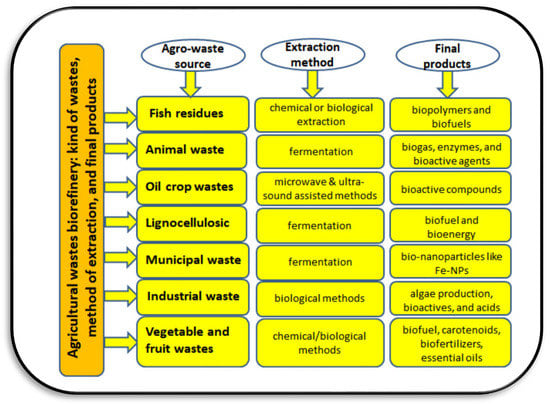
Figure 8. Common methods used in the processing and biorefinery of agro-wastes to produce bioproducts.
Water and energy security both have a close relationship with food security. Moreover, the ever-increasing global population puts more demand on water and energy resources. Bioenergy (e.g., biogas, biohydrogen, bioethanol, biodiesel, etc.) can be generated from several agricultural and related wastes. Biofuels produced from agro-wastes have many advantages over fossil fuels like lower pollution rates (Figure 9 and Figure 10; [85]). Due to high efficiency, negligible CO2 emissions during combustion, sustainability, economic feasibility, and biodegradability, additional research and development of biofuels should be undertaken [85].
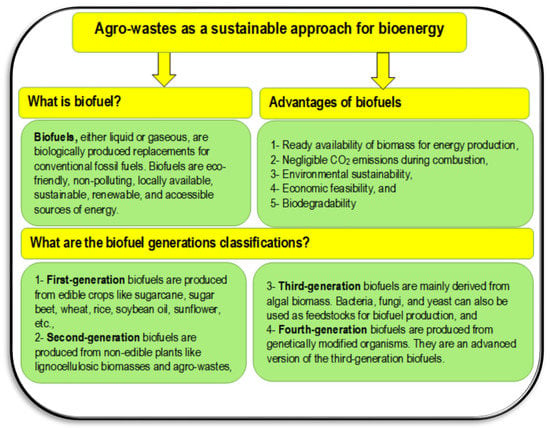
Figure 9. A general classification of biofuels along with applications and mechanisms for generating these biofuels.
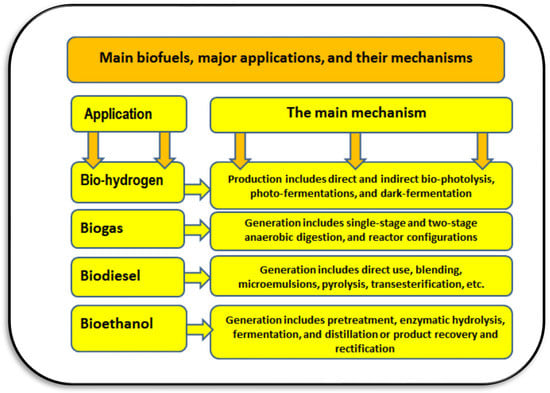
Figure 10. The main biofuels and the primary mechanisms for manufacturing them.
2.4. Agro-Wastes for Plant Tissue Culture Media
The agricultural industry has been fundamental for human survival for thousands of years [86]. However, modern agriculture generates tons of organic agricultural wastes such as inedible plant tissues (shells, peels, stalks, etc.) [87]. The rapid expansion of cities and human population has led to millions of tons of solid waste generation annually, which has serious implications for pollution of the global environment. Waste management systems that include storage, collection, transportation, segregation, processing and disposal of waste are very expensive and require technology that is not readily available in poor developing countries. Proper management of these wastes is essential to protect the environment and practice sustainable utilization of the available resources. This may include making compost for soil application or substitutional media for microorganisms. Agro-wastes can be used to prepare environmentally safe alternative plant tissue culture media that is less expensive than current commercial artificial media [88].
For example, cost-effective media for plant tissue culture have been formulated using the wastes of cabbage, beetroot, and onion. The agro-wastes were dried, then ground to powder. Coconut water was added as a source of natural hormone (cytokinin). This alternative medium could be used to grow plants because it contains micro and macronutrients within required ranges. It is useful for laboratory applications and at the industrial level for large scale production of plants [88]. It is a new strategy to produce the components of tissue culture media from farm wastes. This is a possible sustainable solution to protect the environment and preserve natural resources.
References
- Ioannou, Z.; Kavvadias, V.; Karasavvidis, C. Recycling of agricultural wastes: Treatment and uses. In Agricultural Wastes: Characteristics, Types, and Management; Foster, C.N., Ed.; Nova Science Publishers, Inc.: New York, NY, USA, 2015; pp. 1–21.
- Ramírez-García, R.; Gohil, N.; Singh, V. Recent Advances, Challenges, and Opportunities in Bioremediation of Hazardous Materials. In Phytomanagement of Polluted Sites Market Opportunities in Sustainable Phytoremediation; Pandey, V.M., Bauddh, K., Eds.; Elsevier Inc.: Amsterdam, The Netherlands, 2019; pp. 517–568.
- Chen, C.; Chaudhary, A.; Mathys, A. Nutritional and environmental losses embedded in global food waste. Resour. Conserv. Recycl. 2020, 160, 104912.
- Benyam, A.; Soma, T.; Fraser, E. Digital agricultural technologies for food loss and waste prevention and reduction: Global trends, adoption opportunities and barriers. J. Clean. Prod. 2021, 323, 129099.
- Ogunmoroti, A.; Liu, M.; Li, M.; Liu, W. Unraveling the environmental impact of current and future food waste and its management in Chinese provinces. Resour. Environ. Sustain. 2022, 9, 100064.
- Kamel, R.; El-Wakil, N.A.; Dufresne, A.; Nermeen, A.; Elkasabgy, N.A. Nanocellulose: From an agricultural waste to a valuable pharmaceutical ingredient. Int. J. Biol. Macromol. 2020, 163, 1579–1590.
- El-Bassi, L.; Azzaz, A.A.; Jellali, S.; Akrout, H.; Marks, E.A.N.; Ghimbeu, C.M.; Jeguirim, M. Application of olive mill waste-based biochars in agriculture: Impact on soil properties, enzymatic activities and tomato growth. Sci. Total Environ. 2021, 755, 142531.
- Kwoczynski, Z.; Cmelík, J. Characterization of biomass wastes and its possibility of agriculture utilization due to biochar production by torrefaction process. J. Clean. Prod. 2021, 280, 124302.
- Peerzada, J.G.; Chidambaram, R. A Statistical Approach for Biogenic Synthesis of Nano-Silica from Different Agro-Wastes. Silicon 2020, 13, 2089–2101.
- Singh, S.P.; Endley, N. Fabrication of nano-silica from agricultural residue and their application. In Nanomaterials for Agriculture and Forestry Applications; Husen, A., Jawaid, M., Eds.; Elsevier Inc.: Amsterdam, The Netherlands, 2020; pp. 117–134.
- Suffo, M.; de la Mata, M.; Molina, S.I. A sugar beet waste based thermoplastic agro-composite as substitute for raw materials. J. Clean. Prod. 2020, 257, 120382.
- Fareed, A.; Zaidi, S.B.A.; Ahmad, N.; Hafeez, I.; Ali, A.; Ahmad, M.F. Use of agricultural waste ashes in asphalt binder and mixture: A sustainable solution to waste management. Constr. Build. Mater. 2020, 259, 120575.
- Mo, K.H.; Thomas, B.S.; Yap, S.P.; Abutaha, F.; Tan, C.G. Viability of agricultural wastes as substitute of natural aggregate in concrete: A review on the durability-related properties. J. Clean. Prod. 2020, 275, 123062.
- Landin-Sandoval, V.J.; Mendoza-Castillo, D.I.; BonillaPetriciolet, A.; Aguayo-Villarreal, I.A.; Reynel-Avila, H.E.; Gonzalez-Ponce, H.A. Valorization of agri-food industry wastes to prepare adsorbents for heavy metal removal from water. J. Environ. Chem. Eng. 2020, 8, 104067.
- Siles-Castellano, A.B.; López, M.J.; Jurado, M.M.; SuárezEstrella, F.; López-González, J.A.; Estrella-González, M.J.; Moreno, J. Industrial composting of low carbon/nitrogen ratio mixtures of agri-food waste and impact on compost quality. Bioresour. Technol. 2020, 316, 123946.
- Donner, M.; Gohier, R.; de Vries, H. A new circular business model typology for creating value from agrowaste. Sci. Total Environ. 2020, 716, 137065.
- Koutra, E.; Mastropetros, S.G.; Ali, S.S.; Tsigkou, K.; Kornaros, M. Assessing the potential of Chlorella vulgaris for valorization of liquid digestates from agro-industrial and municipal organic wastes in a biorefinery approach. J. Clean. Prod. 2021, 280, 124352.
- Uddin, M.N.; Siddiki, S.Y.A.; Mofijur, M.; Djavanroodi, F.; Hazrat, M.A.; Show, P.L.; Ahmed, S.F.; Chu, Y.-M. Prospects of Bioenergy Production from Organic Waste Using Anaerobic Digestion Technology: A Mini Review. Front. Energy Res. 2021, 9, 627093.
- Arun, K.B.; Madhavan, A.; Sindhu, R.; Binod, P.; Pandey, A.; Reshmy, R.; Sirohi, R. Remodeling agroindustrial and food wastes into value-added bioactives and biopolymers. Ind. Crops Prod. 2020, 154, 112621.
- Ben-Othman, S.; Jõudu, I.; Bhat, R. Bioactives from Agri-Food Wastes: Present Insights and Future Challenges. Molecules 2020, 25, 510.
- Gullón, P.; Gullón, B.; Romaní, A.; Rocchetti, G.; Lorenzo, J.M. Smart advanced solvents for bioactive compounds recovery from agri-food by-products: A review. Trends Food Sci. Technol. 2020, 101, 182–197.
- Lemes, A.C.; Egea, M.B.; Oliveira Filho, J.G.d.; Gautério, G.V.; Ribeiro, B.D.; Coelho, M.A.Z. Biological Approaches for Extraction of Bioactive Compounds from Agroindustrial By-products: A Review. Front. Bioeng. Biotechnol. 2022, 9, 802543.
- Braun, R.; Hertweck, D.; Eicker, U. An approach to cluster the research field of the food-energy-water nexus to determine modeling capabilities at different levels using text mining and cluster analysis. Energy Nexus 2022, 7, 100101.
- Couto, L.C.; Campos, L.C.; da Fonseca-Zang, W.; Zang, J.; Bleischwitz, R. Water, waste, energy and food nexus in Brazil: Identifying a resource interlinkage research agenda through a systematic review. Renew. Sustain. Energy Rev. 2021, 138, 110554.
- Lin, H.; Borrion, A.; da Fonseca-Zang, W.A.; Zang, J.W.; Leandro, W.M.; Campos, L.C. Life cycle assessment of a biogas system for cassava processing in Brazil to close the loop in the water-waste-energy-food nexus. J. Clean. Prod. 2021, 299, 126861.
- Afkhami, P.; Zarrinpoor, N. The energy-water-food-waste-land nexus in a GIS-based biofuel supply chain design: A case study in Fars province, Iran. J. Clean. Prod. 2022, 340, 130690.
- El-Ramady, H.; Brevik, E.C.; Elsakhawy, T.; Omara, A.E.D.; Amer, M.; Abowaly, M.; El-Henawy, A.; Prokisch, J. Soil and Humans: A Comparative and A Pictorial Mini-Review. Egypt. J. Soil Sci. 2022, 62, 101–122.
- Brevik, E.C.; Omara, A.E.D.; Elsakhawy, T.; Amer, M.; Fawzy, Z.F.; El-Ramady, H.; Prokisch, J. The Soil-Water-Plant-Human Nexus: A Call for Photographic Review Articles. Environ. Biodivers. Soil Secur. 2022, 6, 117–131.
- El-Ramady, H.; Faizy, S.E.D.; Amer, M.M.; Elsakhawy, T.; Omara, A.E.D.; Eid, Y.; Brevik, E.C. Management of Salt-Affected Soils: A Photographic Mini-Review. Environ. Biodivers. Soil Secur. 2022, 6, 61–79.
- Koriem, M.A.; Gaheen, S.A.; El-Ramady, H.; Prokisch, J.; Brevik, E.C. Global Soil Science Education to Address the Soil–Water–Climate Change Nexus. Environ. Biodivers. Soil Secur. 2022, 6, 27–39.
- El-Ramady, H.; Törős, G.; Badgar, K.; Llanaj, X.; Hajdú, P.; El-Mahrouk, M.E.; Abdalla, N.; Prokisch, J. A Comparative Photographic Review on Higher Plants and Macro-Fungi: A Soil Restoration for Sustainable Production of Food and Energy. Sustainability 2022, 14, 7104.
- El-Ramady, H.; Hajdú, P.; Töros, G.; Badgar, K.; Llanaj, X.; Kiss, A.; Abdalla, N.; Omara, A.E.-D.; Elsakhawy, T.; Elbasiouny, H.; et al. Plant Nutrition for Human Health: A Pictorial Review on Plant Bioactive Compounds for Sustainable Agriculture. Sustainability 2022, 14, 8329.
- Bayoumi, Y.; Shalaby, T.A.; Fawzy, Z.A.; Shedeed, S.I.; Taha, N.; El-Ramady, H.; Prokisch, J. Grafting of Vegetable Crops in the Era of Nanotechnology: A photographic Mini Review. Environ. Biodivers. Soil Secur. 2022, 6, 133–148.
- Fawzy, Z.F.; El-Ramady, H.; Abd El-Fattah, D.A.; Prokisch, J. Sustainable Applications of Mushrooms in Soil Science: A Call for Pictorial Articles. Egypt. J. Soil Sci. 2022, 62, 101–115.
- Fawzy, Z.F.; El-Ramady, H.; Omara, A.E.D.; Elsakhawy, T.; Bayoumi, Y.; Shalaby, T.A.; Prokisch, J. From Farm-to-Fork: A pictorial Mini Review on Nano-Farming of Vegetables. Environ. Biodivers. Soil Secur. 2022, 6, 149–163.
- Fawzy, Z.F.; El-Ramady, H. Applications and Challenges of Smart Farming for Developing Sustainable Agriculture. Environ. Biodivers. Soil Secur. 2022, 6, 81–90.
- Fawzy, Z.F.; El-Sawy, S.M.; El-Bassiony, A.M.; Zhaojun, S.; Okasha, A.M.; Bayoumi, Y.; El-Ramady, H.; Prokisch, J. Is the Smart Irrigation the Right Strategy under the Global Water Crisis? A Call for Photographical and Drawn Articles. Environ. Biodivers. Soil Secur. 2022, 6, 207–221.
- Fawzy, Z.F.; El-Sawy, S.M.; El-Bassiony, A.M.; Jun, H.; Shedeed, S.I.; Okasha, A.M.; Bayoumi, Y.; El-Ramady, H.; Prokisch, J. Smart Fertilizers vs. Nano-fertilizers: A Pictorial Overview. Environ. Biodivers. Soil Secur. 2022, 6, 191–204.
- Capanoglu, E.; Nemli, E.; Tomas-Barberan, F. Novel Approaches in the Valorization of Agricultural Wastes and Their Applications. J. Agric. Food Chem. 2022, 70, 6787–6804.
- Gupta, J.; Kumari, M.; Mishra, A.; Akram, M.; Thakur, I.S. Agro-forestry waste management-A review. Chemosphere 2022, 287, 132321.
- Yaashikaa, P.R.; Kumar, P.S.; Varjani, S. Valorization of agro-industrial wastes for biorefinery process and circular bioeconomy: A critical review. Bioresour. Technol. 2022, 343, 126126.
- Maraveas, C. Production of Sustainable and Biodegradable Polymers from Agricultural Waste. Polymers 2020, 12, 1127.
- Formela, K.; Kuranska, M.; Barczewski, M. Recent Advances in Development of Waste-Based Polymer Materials: A Review. Polymers 2022, 14, 1050.
- Shrivastava, R.; Singh, N.K. Agro-wastes sustainable materials for wastewater treatment: Review of current scenario and approaches for India. Mater. Today Proc. 2022, 60, 552–558.
- Leite, P.; Belo, I.; Salgado, J.M. Co-management of agro-industrial wastes by solid-state fermentation for the production of bioactive compounds. Ind. Crops Prod. 2021, 172, 113990.
- Mendez-Carmona, J.Y.; Ramírez-Guzman, K.N.; Ascacio-Valdes, J.A.; Sepulveda, L.; Aguilar, C.N. Solid-state fermentation for recovery of carotenoids from tomato waste. Innov. Food Sci. Emerg. Technol. 2022, 80, 103108.
- Reguengo, L.M.; Salgaço, M.K.; Sivieri, K.; Júnior, M.R.M. Agro-industrial by-products: Valuable sources of bioactive compounds. Food Res. Int. 2022, 152, 110871.
- Chen, C.Y.O.; Milbury, P.E.; Blumberg, J.B. Polyphenols in almond skins after blanching modulate plasma biomarkers of oxidative stress in healthy humans. Antioxidants 2019, 8, 95.
- Nile, S.H.; Nile, A.; Liu, J.; Kim, D.H.; Kai, G. Exploitation of apple pomace towards extraction of triterpenic acids, antioxidant potential, cytotoxic effects, and inhibition of clinically important enzymes. Food Chem. Toxicol. 2019, 131, 110563.
- Kraithong, S.; Issara, U. A strategic review on plant by-product from banana harvesting: A potentially bio-based ingredient for approaching novel food and agro-industry sustainability. J. Saudi Soc. Agric. Sci. 2021, 20, 530–543.
- Otify, A.M.; El-Sayed, A.M.; Michel, C.G.; Farag, M.A. Metabolites profiling of date palm (Phoenix dactylifera L.) commercial by-products (pits and pollen) in relation to its antioxidant effect: A multiplex approach of MS and NMR metabolomics. Metabolomics 2019, 15, 119.
- Sangpong, L.; Khaksar, G.; Pinsorn, P.; Oikawa, A.; Sasaki, R.; Erban, A.; Watanabe, M.; Wangpaiboon, K.; Tohge, T.; Kopka, J.; et al. Assessing dynamic changes of taste-related primary metabolism during ripening of durian pulp using metabolomic and transcriptomic analyses. Front. Plant Sci. 2021, 12, 687799.
- Dorado, C.; Cameron, R.G.; Manthey, J.A.; Bai, J.; Ferguson, K.L. Analysis and potential value of compounds extracted from star ruby, rio red, and ruby red grapefruit, and grapefruit juice processing residues via steam explosion. Front. Nutr. 2021, 8, 691663.
- Long, J.M.; Mohan, A. Food flavoring prepared with lemon byproduct. J. Food Process. Preserv. 2021, 45, e15462.
- Wall-Medrano, A.; Olivas-Aguirre, F.J.; Ayala-Zavala, J.F.; Domínguez-Avila, J.A.; Gonzalez Aguilar, G.A.; Herrera-Cazares, L.A.; Gaytan-Martinez, M. Health benefits of mango by-products. In Food Wastes and By-Products: Nutraceutical and Health Potential; Campos-Vega, R., Oomah, B.D., Vergara-Castaneda, H.A., Eds.; Blackwell Publishing: Hoboken, NJ, USA, 2020; pp. 159–191.
- Campos, D.A.; Ribeiro, T.B.; Teixeira, J.A.; Pastrana, L.; Pintado, M.M. Integral valorization of pineapple (Ananas comosus L.) by-products through a green chemistry approach towards added value ingredients. Foods 2020, 9, 60.
- Meselhy, K.M.; Shams, M.M.; Sherif, N.H.; El-Sonbaty, S.M. Phytochemical study, potential cytotoxic and antioxidant activities of selected food byproducts (pomegranate peel, Rice bran, Rice straw & mulberry bark). Nat. Prod. Res. 2020, 34, 530–533.
- Villamil-Galindo, E.; Van de Velde, F.; Piagentini, A.M. Strawberry agro-industrial by-products as a source of bioactive compounds: Effect of cultivar on the phenolic profile and the antioxidant capacity. Bioresour. Bioprocess. 2021, 8, 61.
- Gulsunoglu, Z.; Karbancioglu-Guler, F.; Raes, K.; Kilic-Akyilmaz, M. Soluble and insoluble-bound phenolics and antioxidant activity of various industrial plant wastes. Int. J. Food Prop. 2019, 22, 1501–1510.
- Scharf, R.; Wang, R.; Maycock, J.; Ho, P.; Chen, S.; Orfila, C. Valorisation of potato (Solanum tuberosum) peel waste: Extraction of fibre, monosaccharides, and uronic acids. Waste Biomass Valorization 2020, 11, 2123–2128.
- Bodie, A.R.; Micciche, A.C.; Atungulu, G.G.; Rothrock, M.J., Jr.; Ricke, S.C. Current trends of rice milling byproducts for agricultural applications and alternative food production systems. Front. Sustain. Food Syst. 2019, 3, 47.
- Carneiro, A.M.; Moreira, E.A.; Bragagnolo, F.S.; Borges, M.S.; Pilon, A.C.; Rinaldo, D.; Funari, C.S. Soya agricultural waste as a rich source of isoflavones. Food Res. Int. 2020, 130, 108949.
- Coelho, M.; Pereira, R.; Rodrigues, A.S.; Teixeira, J.A.; Pintado, M.E. Extraction of tomato by-products’ bioactive compounds using ohmic technology. Food Bioprod. Process. 2019, 117, 329–339.
- Seifdavati, J.; Seifzadeh, S.; Ramezani, M.; Mashak, R.B.; Seyedsharifi, R.; Elghandour, M.M.M.Y.; Barbabosa-Pliego, A.; Salem, A.Z.M. Wastes valorization of wheat straw and wheat bran treated with urea, probiotic or organic acids to enhance ruminal gas production and digestibility of pumpkin by-product. Waste Biomass Valorization 2021, 12, 5979–5989.
- Maji, S.; Dwivedi, D.H.; Singh, N.; Kishor, S.; Gond, M. Agricultural Waste: Its Impact on Environment and Management Approaches. In Emerging Eco-Friendly Green Technologies for Wastewater Treatment; Bharagava, R.N., Ed.; Microorganisms for Sustainability; Springer Nature Singapore Pte Ltd.: Singapore, 2020; pp. 329–351.
- Shaaban, S.; Nasr, M. Toward Three R’s Agricultural Waste in MENA: Reduce, Reuse, and Recycle. In Waste Management in MENA Regions; Negm, A., Shareef, N., Eds.; Springer Nature: Cham, Switzerland, 2020; pp. 337–353.
- El-Ramady, H.; El-Henawy, A.; Amer, M.; Omara, A.E.D.; Elsakhawy, T.; Elbasiouny, H.; Elbehiry, F.; Abou Elyazid, D.; El-Mahrouk, M. Agricultural Waste and its Nano-Management: Mini Review. Egypt. J. Soil. Sci. 2020, 60, 349–364.
- Li, S.; Chen, G. Agricultural waste-derived superabsorbent hydrogels: Preparation, performance and socioeconomic impacts. J. Clean. Prod. 2020, 251, 119669.
- Imran, A.; Sardar, F.; Khaliq, Z.; Nawaz, M.S.; Shehzad, A.; Ahmad, M.; Yasmin, S.; Hakim, S.; Mirza, B.S.; Mubeen, F.; et al. Tailored Bioactive Compost from AgriWaste Improves the Growth and Yield of Chili Pepper and Tomato. Front. Bioeng. Biotechnol. 2022, 9, 787764.
- Bhattacharjya, S.; Sahu, A.; Phalke, D.H.; Manna, M.C.; Thakur, J.K.; Mandal, A.; Tripathi, A.K.; Sheoran, P.; Choudhary, M.; Bhowmick, A.; et al. In Situ decomposition of Crop Residues Using Lignocellulolytic Microbial Consortia: A Viable Alternative to Residue Burning. Environ. Sci. Pollut. Res. Int. 2021, 28, 32416–32433.
- Sharma, S.; Singh, P.; Choudhary, O.P.; Neemisha, F.N.M. Nitrogen and rice Straw Incorporation Impact Nitrogen Use Efficiency, Soil Nitrogen Pools and Enzyme Activity in rice-wheat System in north-western India. Field Crops Res. 2021, 266, 108131.
- Imran, A.; Hakim, S.; Tariq, M.; Nawaz, M.S.; Laraib, I.; Gulzar, U.; Hanif, M.K.; Siddique, M.J.; Hayat, M.; Fraz, A.; et al. Diazotrophs for Lowering Nitrogen Pollution Crises: Looking Deep into the Roots. Front. Microbiol. 2021, 12, 637815.
- Khaksar, G.; Sirijan, M.; Suntichaikamolkul, N.; Sirikantaramas, S. Metabolomics for Agricultural Waste Valorization: Shifting Toward a Sustainable Bioeconomy. Front. Plant Sci. 2022, 13, 938480.
- Jones, S.L.; Gibson, K.E.; Ricke, S.C. Critical Factors and Emerging Opportunities in Food Waste Utilization and Treatment Technologies. Front. Sustain. Food Syst. 2021, 5, 781537.
- Patra, A.; Abdullah, S.; Pradhan, R.C. Review on the extraction of bioactive compounds and characterization of fruit industry by-products. Bioresour. Bioprocess. 2022, 9, 14.
- Parras-Alcántara, L.; Lozano-García, B.; Keesstra, S.; Cerdà, A.; Brevik, E.C. Long-term effects of soil management on ecosystem services and soil loss estimation in olive grove topsoils. Sci. Total Environ. 2016, 571, 498–506.
- De Souza, A.G.; Barbosa, R.F.S.; Rosa, D.S. Nanocellulose from Industrial and Agricultural Waste for Further Use in PLA Composites. J. Polym. Environ. 2020, 28, 1851–1868.
- Abdelbasir, S.M.; McCourt, K.M.; Lee, C.M.; Vanegas, D.C. Waste-Derived Nanoparticles: Synthesis Approaches, Environmental Applications, and Sustainability Considerations. Front. Chem. 2020, 8, 782.
- Brevik, E.C.; Hartemink, A.E. Early soil knowledge and the birth and development of soil science. Catena 2010, 83, 23–33.
- Pavalaydon, K.; Ramasawmy, H.; Surroop, D. Comparative evaluation of cellulose nanocrystals from bagasse and coir agro-wastes for reinforcing PVA-based composites. Environ. Dev. Sustain. 2022, 24, 9963–9984.
- Gómez, J.A.; Berni, P.; Matallana, L.G.; Sánchez, Ó.J.; Teixeira, J.A.; Nobre, C. Towards a biorefinery processing waste from plantain agro–Industry: Process development for the production of an isomalto–oligosaccharide syrup from rejected unripe plantain fruits. Food Bioprod. Process. 2022, 133, 100–118.
- Reddy, R.; Sridevi, V.; Kumar, T.H.; Rao, C.S.; Palla, V.C.S.; Suriapparao, D.V.; Undi, G.S. Synthesis of renewable carbon biorefinery products from susceptor enhanced microwave-assisted pyrolysis of agro-residual waste: A review. Process Saf. Environ. Prot. 2022, 164, 354–372.
- Sachdeva, S.; Garg, V.K.; Labhsetwar, N.K.; Singh, A.; Yogalakshmi, K.N. Zero Waste Biorefinery: A Comprehensive Outlook. In Zero Waste Biorefinery; Nandabalan, Y.K., Garg, V.K., Labhsetwar, N.K., Singh, A., Eds.; Energy, Environment, and Sustainability; Springer Nature Singapore Pte Ltd.: Singapore, 2022; pp. 1–22.
- Mukhtar, H. Waste to Energy: Biomass-Based Energy Systems. Front. Bioeng. Biotechnol. 2022, 10, 932981.
- Nair, L.G.; Agrawal, K.; Verma, P. An overview of sustainable approaches for bioenergy production from agro-industrial wastes. Energy Nexus 2022, 6, 100086.
- Subbaiya, R.; Aakash, B.; Shanmugaraja, A.; Devika, R.; Chozhavendhan, S.; Vinoth, S.; Karthiga Devi, G.; Masilamani Selvam, M. Vegetable Waste as an Alternate Plant Tissue Culture Media for Laboratory and Industry. Res. J. Pharm. Technol. 2019, 12, 1521–1528.
- Moscariello, C.; Matassa, S.; Esposito, G.; Papirio, S. From residue to resource: The multifaceted environmental and bioeconomy potential of industrial hemp (Cannabis sativa L.). Resour. Conserv. Recycl. 2021, 175, 105864.
- UN (United Nations). Transforming Our World: The 2030 Agenda for Sustainable Development; Resolution, Adopted by the General Assembly on 25 September 2015. United Nations, New York. Available online: https://www.unfpa.org/sites/default/files/resource-pdf/Resolution_A_RES_70_1_EN.pdf (accessed on 20 October 2022).
More
